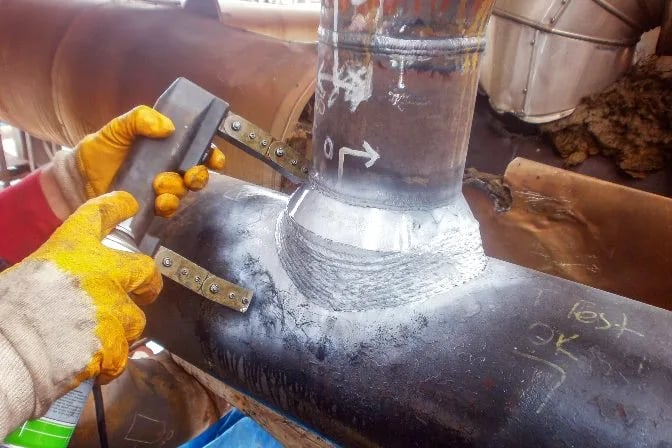Vital Pipeline Welding Examination Tips for Quality Control
How can one guarantee the quality of these welds that link the pipe sections? By understanding the necessary pipe welding assessment pointers, specialists can avoid potential threats, decrease pricey repair work, and promote the dependability of these important infrastructures.

Importance of Welding Evaluation
Welding examination plays a critical role in ensuring the architectural honesty and safety and security of pipeline systems. By thoroughly analyzing welds, assessors can determine any kind of issues or blemishes that might endanger the integrity of the pipe. These evaluations are vital for stopping leakages, ruptures, and other potentially catastrophic failures that could result in environmental damages, economic losses, and even death.
The importance of welding evaluation can not be overemphasized, as the top quality of welds directly affects the general performance and longevity of the pipeline. Via non-destructive screening techniques such as aesthetic examination, ultrasonic screening, radiography, and magnetic bit screening, inspectors can discover flaws that might not show up to the nude eye. By recognizing and dealing with these issues at an early stage, welding assessment aids to ensure that pipes satisfy industry criteria and governing needs.
Ultimately, welding assessment is a crucial element of quality guarantee in pipeline construction, upkeep, and fixing (Pipeline Welding Inspection). By upholding strenuous inspection requirements, industry professionals can minimize dangers and maintain the safety and dependability of pipe systems
Common Welding Issues
Among the challenges faced in pipe welding, usual problems can dramatically affect the architectural integrity and efficiency of the bonded joints. Several of the most prevalent welding problems consist of lack of combination, porosity, fractures, insufficient penetration, and imbalance. Absence of fusion takes place when there is inadequate bonding between the weld metal and the base steel, causing a damaged joint. Porosity, characterized by gas pockets within the weld, can reduce the stamina and make the weld susceptible to rust. Splits in the weld can propagate gradually, compromising the architectural stability of the pipe. Insufficient infiltration takes place when the weld metal does not totally penetrate the joint, resulting in a weak bond. Imbalance, where the weld bead is not effectively centered, can bring about tension focus factors and potential failing. Discovering and attending to these usual problems through extensive assessment and quality control procedures are important for making certain the dependability and safety and security of pipeline welds.
Assessment Strategies for Pipes
In guaranteeing the structural stability and integrity of pipe welds, the application of strenuous examination techniques is critical. Different assessment techniques are utilized to find potential defects and guarantee the general high quality of the welds. Non-destructive testing (NDT) methods such as radiographic screening, ultrasonic screening, magnetic fragment screening, and fluid penetrant screening are commonly utilized in pipeline welding evaluation. Radiographic testing includes making use of X-rays or gamma rays to find inner flaws, while ultrasonic screening makes use of high-frequency sound waves to identify imperfections. Magnetic particle testing is efficient for detecting surface-breaking defects, and liquid penetrant screening is made use of to identify surface area splits. Aesthetic examination is additionally important in pipeline you could try this out welding to identify any noticeable flaws or interruptions. Furthermore, automatic inspection strategies using advanced modern technologies like drones and robotics are progressively being employed to boost the efficiency and precision of pipeline evaluations. By using a combination of these examination methods, pipeline bonded quality can be ensured, and prospective issues can be alleviated before they intensify into larger troubles.
Ensuring High Quality Assurance Specifications
To promote rigid top quality guarantee standards in pipeline construction, precise adherence to established market procedures and guidelines is necessary. Quality guarantee in welding procedures calls site link for a comprehensive approach encompassing various phases of pipe construction. Implementing a durable top quality monitoring system that consists of routine audits and evaluations can additionally improve the overall quality guarantee criteria in pipe welding.
Stopping Expensive Repair Work
Provided the critical significance of keeping strict high quality guarantee criteria in pipeline construction, a positive technique to protecting against costly repairs is vital. Routine upkeep checks and monitoring of environmental factors that could impact the stability of the pipeline are likewise important in protecting against costly fixings. By investing in preventative steps and focusing on quality assurance at every stage of the pipe welding procedure, companies can lessen the danger of expensive repairs and make certain the long-lasting dependability of their facilities.
Final Thought
Finally, adherence to appropriate welding evaluation strategies is crucial for ensuring the quality and honesty of pipelines. By determining typical welding issues and implementing extensive examination procedures, pricey repairs can be protected against, and top quality assurance standards can be met - Pipeline Welding Inspection. It is crucial for pipeline welders to prioritize examination treatments to preserve the security and dependability of the framework they are servicing
The relevance of welding inspection can not be overstated, as the high quality of welds directly influences the total performance and long life of the pipeline. Non-destructive testing (NDT) methods such as radiographic screening, ultrasonic testing, magnetic particle testing, and fluid penetrant testing are frequently made use of in pipeline welding inspection. Visual inspection is likewise vital in pipe welding to determine any kind of visible defects or discontinuities. In addition, automated assessment techniques using advanced modern technologies like drones and robotics are increasingly being used to enhance the effectiveness and accuracy of pipeline inspections.In like it conclusion, adherence to correct welding inspection techniques is crucial for making sure the quality and honesty of pipes.